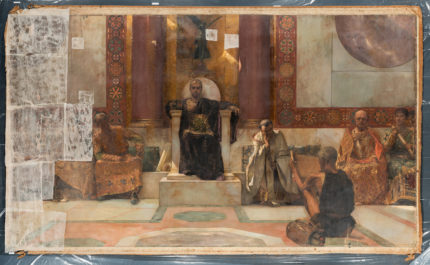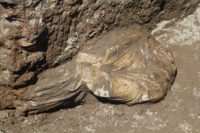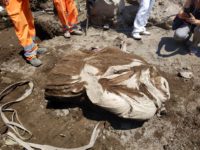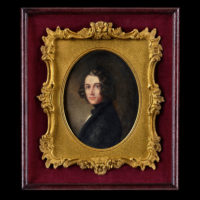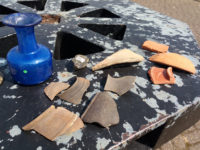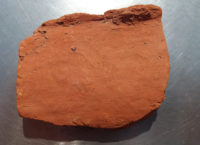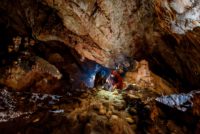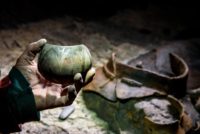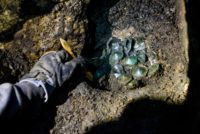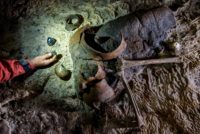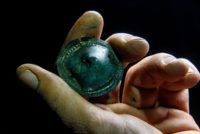A monumental oil on canvas painting in dire need of conservation will get the help it needs thanks to a $176,800 grant from the Getty Foundation. Emperor Justinian, made in 1886 by Orientalist French painter Jean-Joseph Benjamin-Constant and now in the permanent collection of the John and Mable Ringling Museum of Art in Sarasota, Florida, will be restored as part of the Getty’s Conserving Canvas initiative, which provides funds and expertise in the latest conservation methods that will be taught to the trainees in the program.
For centuries, it was common practice to protect canvas paintings by backing or lining them with another canvas to create a moisture barrier and provide greater structural integrity, but a shift toward minimal intervention has produced a knowledge gap among today’s museum conservators in how to treat lined paintings.
Conserving Canvas aims to ensure that conservators remain fully prepared to care for these important works of art through a combination of training activities and information dissemination. […]
The John F. and Herta Cuneo Conservation Laboratory at The Ringling will partner with Artcare Conservation to carry out the conservation treatment of “Emperor Justinian” in its Miami studio. International collaboration involves four postgraduate mid-career painting conservators from the United States, Canada and Colombia who have been invited to participate as trainees in various stages of the structural treatment. Two junior painting conservators at The Ringling will also take part as trainees.
Jean-Joseph Benjamin-Constant was a Parisian painter who, influenced by a voyage to Spain and Morocco in 1872, became enamored with Orientalist style and subjects. He was known for large-scale pieces, murals in particular after 1880, and Emperor Justinian is one of his larger works at 13.3 x 22 feet. You can see the influence of Moroccan design in the tile and fabrics. The rich golds and red, characteristic elements of his palette, still manage to shine even after years of neglect and damage.
The work has only been owned by two people. Dry goods magnate and avid art collector Godfrey Mannheimer bought it from the artist in 1887. He donated it the Metropolitan Museum of Art in 1890 and for a time at the turn of the century is was prominently displayed there, but in 1928 the museum returned it to the donor’s family, namely Mamie Manheimer (Godfrey’s daughter) and her husband Dr. Leonard Dessar. John Ringling bought the monumental canvas from them in 1928.
Son a German immigrant harness maker, John Ringling was born in Iowa to a large family of modest means in 1866. He was 18 when he teamed up with four of his brothers and an established showman to form The Yankee Robinson and Ringling Bros. Double Show. Less than five years later in 1888, the Ringling Brothers had their own show. They were innovators — the circus first to travel the country by train — and when they bought Barnum & Bailey in 1907, they became the biggest show in the country.
In 1905, John married Mable Burton. His investments in railroad, oil, real estate (at one point he owned 25% of the Sarasota area) and entertainment made him very wealthy, and he and Mable spent lavishly on travel, art and property. John and Mable built a splendid collection, acquiring top quality art works, furnishings and decorative objects on every trip to Europe. They filled Ca’ d’Zan, the sumptuous Venetian Gothic style palace they had built in Sarasota in 1926, with their acquisitions, and the massive 36,000-square-foot mansion gave their collection plenty of room to grow in its 56 rooms.
Mable died in June of 1929 aged just 54 from diabetes and complications from Addison’s disease. John was devastated by the loss of his beloved wife, and his misfortunes would spill over into his finances later that year. The Wall Street Crash hit his investments very hard. Still, he set in motion the vision he and Mable had always had to use their collection as the core of an art museum “to promote education and art appreciation, especially among our young people.” In October of 1931, the John and Mable Ringling Museum of Art opened its doors.
John died in 1936. In his will he bequeathed his entire estate, museum and collection included, to the people of Florida. The state didn’t take on the job of administering the museum with enthusiasm in the first decade. It was only open off-and-on and not maintained properly. In 1946, the first Arthur “Chick” Austin, Jr., an expert in Baroque art, was hired as its first director. From then on, the Ringling Museum of Art developed into one of country’s finest.
In 1980 it was declared the official State Art Museum of Florida. Twenty years later, the State gave Florida State University governance of the museum. Today the museum complex (which includes the Circus Museum, the Historic Asolo Theater, the Ringling Art Library and the John F. and Herta Cuneo Conservation Laboratory), is one of the largest university art complexes in the country.
Emperor Justinian has spent most of its decades in lovely Sarasota rolled up in storage. The paint has flaked very badly and there are a number of holes in the canvas. The flaking on the left side of the work is so severe, protective facings have been applied to the surface to keep any more paint from falling off. The conservation team will first stabilize the paint and reduce the significant distortion in the canvas. Discolored varnish will be removed and areas of paint loss will be judicious filled in. New lining fabric will be affixed to the back of the original canvas to give it structural support.
When conservation is completed, the painting will be given pride of place in one of The Ringling’s largest galleries. I’m eager to see how they frame it. I love a huge frame and a piece that size can take a lot frame.
(Sorry about that shamelessly not-quite-alliterative tile. It was so close, though.)
